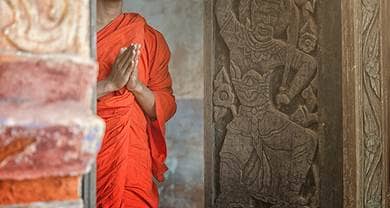- Trending:
- Forgiveness
- |
- Resurrection
- |
- Joy
- |
- Feminism
- |
- Afterlife

RELIGION LIBRARY
Vajrayana Buddhism
Vajrayana Buddhism, also known as the "Diamond" or "Thunderbolt Vehicle," is a form of Buddhism that developed in India in the 5th century C.E. Although it is sometimes debated whether it is a branch of Mahayana Buddhism or if it is a distinct path beside Mahayana and Theravada—this is how the tradition understands itself, as the final "turning" of the Buddha's teachings—it is generally accepted that Vajrayana Buddhism emerged out of the Mahayana in India, probably in the 6th-7th centuries. It rather quickly spread out of India and became established in several parts of the Buddhist world, particularly in Tibet, where it became the dominant form of Buddhism. Indeed, the Vajrayana is often referred to simply as "Tibetan Buddhism." Although it may have originally emerged as a reaction to the philosophical scholasticism of Indian Buddhism, and may have been intended to return to the original teachings and practices of the Buddha, Vajrajyana rapidly developed into a complex philosophical and ritual system. Vajrayana is also sometimes called "Tantric Buddhism," an esoteric extension of Buddhist thought and practice which sees itself as a quicker, more effective path to enlightenment. As with Mahayana Buddhism, the Vajrayana emphasizes the role of the bodhisattva, but the tradition tends to favor fierce deities, and significantly expands the bodhisattva pantheon. Vajrayana ritual and devotion employs mantras (esoteric verbal formulas), mandalas (diagrams and paintings used in visualization practices), and a complex array of other rituals. Great emphasis is placed on the role of the guru in the Vajrayana; these are religious teachers who have mastered the philosophical and ritual tradition. The Tibet translation of guru is "lama," and the various Tibetan schools of the Vajrayana trace long lineages of gurus who serve both as religious and political leaders (the Dalai Lama is the most well known of Tibet's Lamas).
Quick Facts
| Formed | 500 |
| Adherents | 6,000,000 |
| Deity | None / pantheon of deities |
| Sacred Text | Mahayana Canon, various tantras |
| Origin | India |
| Headquarters | None / Tibet |










